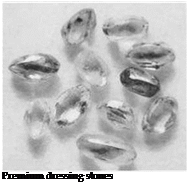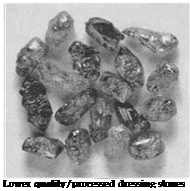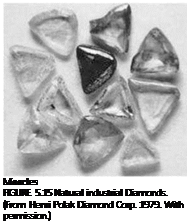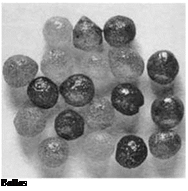 |
 |
Diamond is metastable at room temperatures and pressures and it will convert to graphite given a suitable catalyst or sufficient energy. In a vacuum or in inert gas, diamond remains unchanged up
 |
 |
Premium long stones Lower quality/processed long stones
to 1,500°C; in the presence of oxygen it will begin to degrade at 650°C. This factor plays a significant role in how wheels and tools are processed in manufacturing.
5.6.16 Chemical Affinity of Diamond
Diamond is readily susceptible to chemical degradation from carbide formers, such as tungsten, tantalum, titanium, and zirconium, and true solvents of carbon, which include iron, cobalt, manganese, nickel, chromium, and the Group VIII platinum and palladium metals.
5.6.17 Effects of Chemical Affinity in Manufacture
This chemical affinity can be both a benefit and a curse. It is a benefit in the manufacture of wheels and tools where the reactivity can lead to increased wetting and, therefore, higher bond strengths in metal bonds. For diamond tool manufacture, the reactant is often part of a more complex eutectic alloy (e. g., copper-silver, copper-silver-indium, or copper-tin) in order to minimize processing temperature, disperse and control the active metal reactivity, and/or allow simplified processing in air. Alternatively, tools are vacuum brazed. For metal-bonded wheels, higher temperatures and more wear-resistant alloy bonds are used but fired in inert atmospheres.
